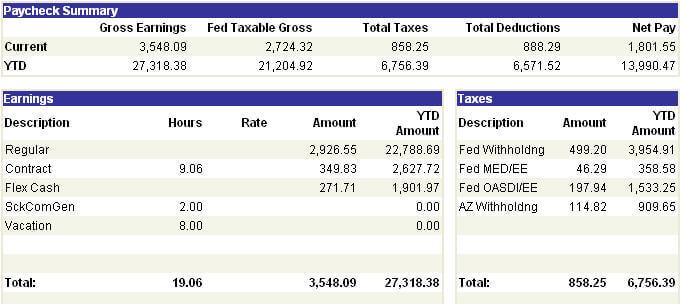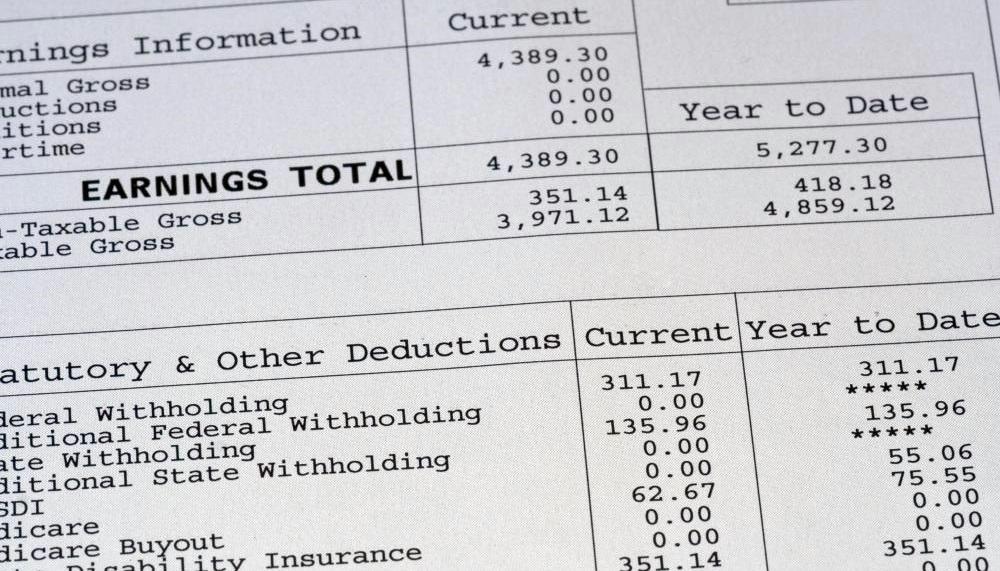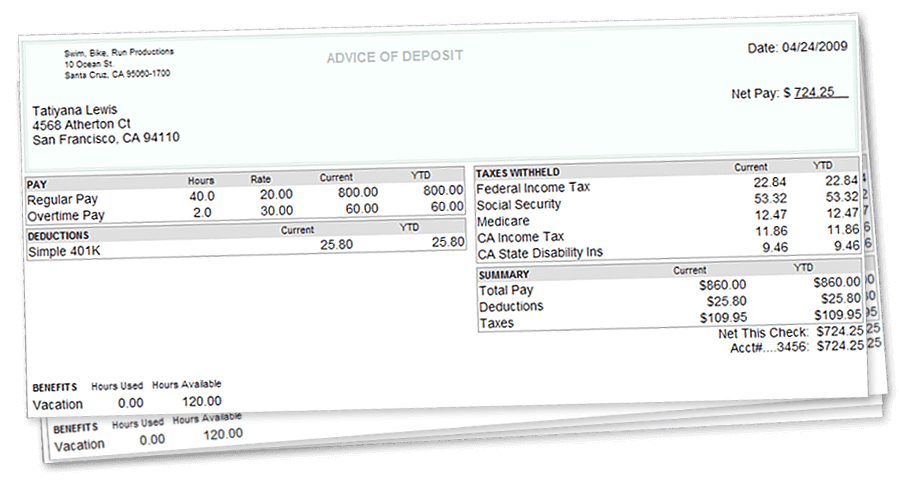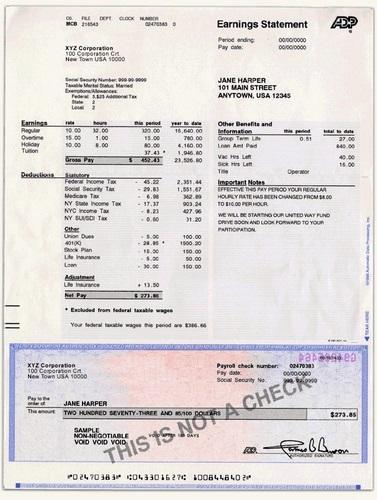Understanding Your Paycheck: Taxes, Withholdings & More
TC
Last updated 04/09/2024 by
Theresa CummingsEveryone is happy when payday comes around. If paid by the hour, most people have a general idea of how much that paycheck will be based upon how many hours have been worked in the pay period. For those with jobs based upon an annual salary, there is also an expectation (based on the monthly salary) as to what the paycheck will be. Many people are disappointed when they see the amount they receive after all the deductions are taken out.
To get a realistic idea of what you’ll receive on your payday, you must first come to an understanding of your paycheck. As you read on, you’ll understand more about the paycheck basics and what all the deductions mean.
Get Competing Personal Loan Offers In Minutes
Compare rates from multiple vetted lenders. Discover your lowest eligible rate.
It's quick, free and won’t hurt your credit score
Paycheck Basics
Every paycheck stub is a legal document and therefore must contain several items. Two things you should see on every check are the pay period and the pay date. The pay period is the time that you worked in for which you are receiving the check. The pay date is the actual day that payment is issued to you as an employee.
You may also see a section that shows your social security number (or part of it) and your marital status and exemptions/allowances. The marital status and number of exemptions you are claiming come from the W-4 form you filled out when you started working for your employer, and those figures can always be adjusted by talking to your payroll department if your situation changes.
Our government allows us to claim deductions for a variety of items (if you have children to support, a business to operate, work travel expenses). The W-4 Form specifically allows you to claim dependents: those who depend on you for support. The more dependents you have, the fewer taxes you are required to pay. However, if you put too many allowances and are underpaying the government, you’re going to have to pay more money during the tax season in the first quarter of the following year. If you are supporting only yourself, people typically claim ‘1’. Some people may even place a zero there, just to overpay and ensure that they will be receiving a return the next time they file their taxes.
Gross Pay vs Net Pay
Many people are confused by the difference between their gross pay and their net pay. Put your gross pay is the total amount you earned during the pay period, and your net pay is the amount you are receiving once all the deductions are taken out.
 So What Are All Those Deductions For?
So What Are All Those Deductions For?
To understand these deductions, we’re going to examine each of them so you can understand exactly what is being deducted from every paycheck you receive so that it makes more sense. (When creating a budget, it must be based on your net pay, since you basically can kiss the deductible income goodbye.)
The first section of deductions is a list of statutory or mandated deductions. These are usually indicated on your check stub under the category Taxes and will most likely include the following:
Federal Tax Withholding
Every country charges its residents a percentage of their wages to run the government and provide a large variety of government services to the population. Believe it or not, many citizens of other countries pay a great deal more than Americans do. The United States adjusts the charge for its population based on the amount of income as well as a person’s circumstances (i.e., single, married, divorced, salaried, hourly wages, etc.) seeking to be as fair as possible to each person. Of course, many people will never be happy with what they are charged, no matter what! The list of things that our government provides us with by using the money charged to us through our taxes is voluminous, and most are quite necessary. That being said, every paycheck has Federal Tax Withheld.
State Tax Withholding
Secondly, every state has the same approach. A portion of your paycheck is withheld to operate your state government and the services they provide you with. Each state determines its percentage rate to withhold to operate the state government. This is what the money deducted as State Tax Withheld, is related to.
 Local Tax Withholding
Local Tax Withholding
Local taxes vary depending on your state and local jurisdiction. Several states have very complicated local tax structures, including Michigan, Pennsylvania, and Ohio, while most states do not impose a local tax at all. If you are subject to Local tax withholding, you will see this line item on your pay stub usually below the state withholding amount.
FICA
If you see a line item that says FICA, that is the deduction for the Federal Insurance Contributions Act tax which both the employee and the employer have to pay. This tax is imposed to fund Social Security and Medicare, both federally run programs that provide benefits for retirees, the disabled, and children of deceased workers.
If you do not see this deduction listed on your check stub, don’t worry because the chances are that you are still paying into the programs and the deductions are listed individually as Social Security and Medicare.
Social Security Deduction
Then we come to the Social Security Employee deduction, which goes into a fund so that you have some financial security when you enter your senior years. In other words, unlike the Federal and State deductions which get applied to the things your government provides to you as a citizen, the social security withholding is actually like a savings account (controlled by the government) which will get paid out once you retire.
This part of the government has been under great scrutiny over recent years due to people living longer than they used to when this plan was set up. This is causing the social security funds to be depleted faster than anticipated, and many fear that it won’t be long before the money runs out.
So if we are all paying into the fund, how can it run out? Simple. There are far more seniors that are taking distributions from the fund than there are working adults paying into it. The solution? Well, we are not sure that there is one yet, which is a great reason why you should be planning and saving towards being able to fund your retirement and not relying on social security still being there when you’re ready to stop working.
 Medicare
Medicare
There will also be an item listed as Medicare, which is another deduction to serve you in your senior years. This is a federal health insurance program, administered by the Social Security Administration, which provides health care for the aged. This is another deduction that is matched by your employer. Employers are required by federal law to match your contribution to both the Social Security and Medicare programs.
State Disability
Another deduction you may see on your paycheck is for state disability. Each state has the right to deduct a small portion of your income to go into the state’s Disability Fund, which you would have access to funding from if you were ever to become disabled.
This line on your paystub will most likely list your state, such as California, followed by Disability or SUI/SDI, (i.e., CA-Disability or CA-SUI/SDI).
Other Deductions
The next set of deductions is more optional (usually) and may be listed on your paycheck stub as Other Deductions or possibly as Adjustments. Many items can fall under this category including your portion of any company-sponsored health plan (including medical, dental, vision, etc.), any garnishment orders received by your employer, 401k contributions, union dues, and more.
Each of these items is all things that your employer should make you aware of before deducting. If you don’t understand other deductions listed, you have the right to ask for an explanation from your Human Resource Director, or Payroll Department.
 Pre-tax vs. Post Tax Deductions
Pre-tax vs. Post Tax Deductions
Another important thing to recognize is that many of your deductions may be listed as Pre-Tax and shown separately on your check stub. These items are deductions that are taken out of your gross pay before taxes are applied. This essentially lowers your total taxable income and therefore lowers the amount of taxes taken out of each check.
Some examples of pre-tax deductions include 401k contributions, medical coverage, and more.
Post-Tax deductions, on the other hand, are deductions that are taken after taxes have already been applied. These deductions usually include any garnishments or loans you need to pay back to your employer and similar items.
Show Me The Money!
Finally, we get to the good part! You should see an actual check in your name usually at the bottom of the pay stub, which is for the amount calculated based on all of the items we discussed above. If you have elected to have your paycheck direct deposited into one or more of your bank accounts, you may see something that looks like a check at the bottom but is just a receipt accounting for where your hard-earned pay went.
If there is anything on your pay stub that you don’t understand, don’t hesitate to go to your company’s administration and find out who can explain deductions to you. You have a right to know!
Share this post: